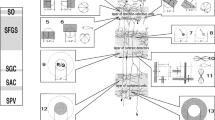Orientation-selective ganglion cells (OS GC) were discovered in the fish retina some decades ago, though the mechanisms of orientational selectivity remain unstudied. OS GC in fish can be divided into two classes, differing in terms of presumptive orientation – close to the vertical or close to the horizontal. There are no differences in the other characteristics of these two classes. They are not selective for contrast sign, i.e., they are on-off in nature. We recorded extracellular activity from retinal tectum opticum GC axon terminals in living immobilized fish, using goldfish as the study system. Stimulus parameters and experimental series were specified using specially developed software. The experiments used a “checkerboard” method with single- and double-point stimulation. OS GC detecting horizontal and vertical edges were able to respond to single flashing points, allowing their excitatory receptive fields to be measured. Responses to this type of stimulus were markedly weaker than those to the preferred stimulus, i.e., the correspondingly oriented lines or edges. However, when stimulation was at two points simultaneously, to approximate a segment in the preferred orientation, OS GC responded with prolonged spike discharges. We also observed inhibition, when points were oriented orthogonally to the preferred orientation. Thus, pairs of points served as an adequate approximation of the preferred or orthogonal direction, allowing the local properties of the receptive fields of OS GC to be studied.
Similar content being viewed by others
References
Antinucci, P. and Hindges, R., “Orientation-selective retinal circuits in vertebrates,” Front. Neural Circuits, 12, 11 (2018).
Billota, J. and Abramov, J., “Orientation and direction tuning of goldfish ganglion cells,” Vis. Neurosci., 2, No. 1, 3–13 (1989).
Cronly-Dillon, J. R., “Units sensitive to direction of movement in goldfish tectum,” Nature, 203, 214–215 (1964).
Dervies, S. H. and Baylor, D. A., “Mosaic arrangement of ganglion cell receptive fields in rabbit retina,” J. Neurophysiol., 78, 2048–2060 (1997).
Douglas, R. N. and McGuidan, C. M., “The spectral transmission of freshwater ocular media an interspecific comparison and a guide to potential ultraviolet sensitivity,” Vision Res., 29, No. 7, 871–879 (1989).
Gaestesland, R. C., Howland, B., Lettvin, J. Y., and Pitts, W. H., “Comments on microelectrodes,” Proc. IRE, 47, 1852–1856 (1959).
Govardovskii, V. I., Fyhrguist, N., Reuter, T., et al., “In search of the visual pigment template,” Vis. Neurosci., 17, No. 4, 509–528 (2000).
Jacobson, M. and Gaze, R. M., “Types of visual response from single units in the optic tectum and optic nerve of the goldfish,” J. Exp. Physiol., 49, 199–209 (1964).
Kawasaki, M. and Aoki, K., “Visual responses recorded from the optic tectum of the Japanese dace Tribolodon hakonensis,” J. Comp. Physiol., 152, 147–153 (1983).
Liege, B. and Galand, G., “Types of single-unit visual responses in the trout’s optic tectum,” in: Visual Information Processing and Control of Motor Activity, A. Gudikov (ed.), Bulgarian Academy of Sciences, Sofi a (1971), pp. 63–65.
Maximov, V. V., Maximova, E. M., and Maximov, P. V., “Classification of direction-selective elements recorded in goldfish tectum,” Sens. Sistemy, 19, No. 4, 342–356 (2005).
Maximov, V. V., Maximova, E. M., and Maximov, P. V., “Classification of orientation-selective elements recorded in goldfish tectum,” Sens. Sistemy, 23, No. 1, 13–23 (2009).
Maximova, E. M., Orlov, O. Yu., and Dimentman, A. M., “Studies of the visual system in a number of marine fish species,” Vopr. Ikhtiol., 11, No. 5, 893–899 (1971).
Nath, A. and Schwartz, G. W., “Cardinal orientation selectivity is represented by two distinct ganglion cell types in mouse retina,” J. Neurosci., 16, 3208–3221 (2016).
Vinogradov, Yu. A., Electronic Devices in Electrophysiological, Morphological, and Ethological Research, Preprint No. 13, Far Eastern Branch, USSR Academy of Sciences, Vladivostok (1986).
Wartzok, D. and Marks, W. B., “Directionally selective visual units recorded in optic tectum of the goldfish,” J. Neurophysiol, 36, 588–604 (1973).
Yang, G. and Masland, R. H., “Direct visualization of the dendritic and receptive fields of directionally selective retinal ganglion cells,” Science, 258, 1949–1952 (1992).
Yang, G. and Masland, R. H., “Receptive fields and dendritic structure of directionally selective retinal ganglion cells,” J. Neurosci., 14, 5267–5280 (1994).
Zenkin, G. M. and Pigarev, I. N., “Detector properties of ganglion cells in pike retina,” Biofizika, 14, No. 4, 722–730 (1969).
Author information
Authors and Affiliations
Corresponding author
Additional information
Translated from Sensornye Sistemy, Vol. 34, No. 1, pp. 19–24, January–March, 2020.
Rights and permissions
About this article
Cite this article
Aliper, A.T., Damjanovic, I., Zaichikova, A.A. et al. Fine Structure of the Receptive Fields of Orientation-Selective Ganglion Cells in the Fish Retina. Neurosci Behav Physi 51, 816–819 (2021). https://doi.org/10.1007/s11055-021-01138-7
Received:
Revised:
Accepted:
Published:
Issue Date:
DOI: https://doi.org/10.1007/s11055-021-01138-7




